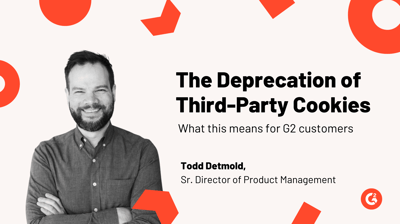February 9, 2022
 by Hannah Stewart / February 9, 2022
by Hannah Stewart / February 9, 2022

Since Google announced the elimination of third-party cookies and Apple announced changes that make Identifiers for Advertisers (IDFAs) significantly less valuable than before, marketers have become increasingly concerned about the cookieless future.
Despite increasing consumer privacy demands, customers still want personalization, which means marketers need to ensure the data they use is clean and accurate. One way to keep this tentative balance is to use cookies that store information and offer consent preferences, but in two years, third-party cookies are set to be a thing of the past.
So if third-party cookies have always worked so well before for both consumers and marketers, why are they going away? If you're a marketer relying on third-party cookies to provide targeted insights as they move through the web, what do you do next?
The cookieless future is a shift in the digital landscape following Google's planned phasing out of third-party cookies in its Chrome browser, announced in January 2020 (now postponed to 2023).
With so much digital marketing activity relying on data from third-party cookies, a large majority of the ad tech sector - as well as publishers, advertisers, and marketers - are in a massive, frenzied race to find viable alternatives.
Alternative identification solutions based on non-cookie identifiers, such as email addresses, will be an essential component of the non-Google technology. However, the quality and volume of its first-party data will likely determine the efficacy of a firm's use of certain cookie replacements, such as alternative ID technologies. Thus, the strategy for many businesses is now shifting toward collecting vast quantities of reliable and accurate customer data.
The term "cookieless" describes a type of marketing where marketers rely less on third-party cookies, which are tiny bits of data exchanged between advertisers that contain personal identifiers as consumers browse the web. This profoundly impacts websites using third-party cookies to identify consumers and target them with relevant advertising or marketing.
Generally, cookies store information about your computer to identify you as an individual visitor by storing unique identifiers like registration numbers or session IDs. With the removal of cookies, however, other identifiers (your IP address, for instance) will uniquely identify your computer to find out more about who you are online.
In short, cookieless means websites store your data using other methods like IP addresses or device IDs as identifiers instead of cookies. These alternative methods will now track you online. In March 2021, Google split from other advertising companies by announcing that it won't collect personally identifiable information (PII) graphs from alternative identifiers like users' email addresses.
While the loss of third-party cookies could still significantly impact marketers relying on analytics data (like session IDs) to target ads, Google opted out of PII collection methods because it has implemented what seems to be a more secure alternative: Federated Learning of Cohorts (FLoC), aka Privacy Sandbox.
Google says FLoC is a "privacy-first" and "interest-based" advertising technology (AdTech). Instead of third-party cookies tracking a user's browsing habits across the web, Google's web browser, Chrome, will do this instead. Users will be placed into an audience or "cohort" grouped according to their habits. Advertisers will then be free to target their ads to these unidentifiable cohorts rather than individual users.
According to Justin Schuh, Google's Director of Chrome Engineering, Google's rationale for phasing out third-party cookies is that users are "demanding more privacy, including transparency, choice, and control over how their data is used." He implied that Google was "evolving" to create "the web ecosystem needed to meet these increasing demands."
None of this is untrue. In fact, 86% of people stated that they felt growing concerns about their data privacy. A further 78% expressed concerns about the amount of data collected.
But there is perhaps another side to Google's decision to rid the web of third-party cookies – The Irish Data Protection Commission's (DPC) investigation into Google's online advertising business. It's no stretch to say that similar high-profile investigations, coupled with growing consumer fears, have created the perfect storm Google is being forced to respond to.
What does that mean for everyone else? When Google first announced its decision to phase out third-party cookies in January 2020, the Association of National Advertisers released a statement. In it, they expressed their "deep disappointment" with Google's decision and acknowledged fears it would "significantly" disrupt the advertising industry.
It went as far as accusing Google of "cutting off the economic oxygen that startups and emerging companies need to survive." A further three-year delay hasn't convinced Google's peers and competitors.
In September 2021, GetApp, an online SaaS resource, partnered with Hubspot to conduct a survey. Their results revealed:
And as for the future? It looks like innovation.
While GetApp's survey found that around 23% of marketers plan to reinvest in email marketing software in 2022, data management platforms (DMPs) and customer data platforms (CDPs) have already developed ways to prepare for such a change.
In fact, customer data platforms have seen an incredible surge in adoption in 2021, with the CDP industry generating an estimated $1.6 billion in revenue. Marketers are slowly moving away from using data management platforms and opting for customer data platforms instead.
This is likely because marketers are investing more in first-party data. DMP relies mainly on third-party data, stores data for shorter periods, and cannot identify users to create the most accurate audiences possible, as a CDP can.
An immediate impact of a future without cookies will be seen in the size of most third-party audiences (audiences whose data is collected solely through third-party cookies). Audience sizes will dwindle to a point where they're no longer scalable enough for media buying activity, leading to low conversion rates and irrelevant targeting.
This means that marketers need to create new audience analysis strategies and rely on other marketing approaches like email marketing. Meanwhile, companies that process and sell advertising data must also develop new ways to securely collect and aggregate audience data that doesn't rely on third-party cookies, where the DMP innovation's first-party methods could prove useful.
And it's these first-party data methods that hold the key to the next steps for businesses and marketers.
In the wake of phasing out third-party cookies, businesses and marketers need to use first-party data as much as possible. First-party data will not go away; instead, only third-party cookies are set to phase out.
First-party data strategies could prove crucial to successfully personalize experiences throughout the customer journey while ensuring data security and relevant, targeted advertising opportunities.
The consensus among data experts indicates that the prerequisite for a future-proof and up-to-date data strategy in the cookieless future is to have a system that can update consumer profiles in real time.
A real-time system can ensure consumer consent is honored when an opt-out occurs on one channel. It keeps data actionable, allowing businesses to act on the data proactively (e.g., opt-in to another engagement on to an adjacent channel). These real-time events activate consumer profiles at scale, delivering end-to-end personalized experiences.
On the other hand, if companies and marketers do nothing, they risk implementing last-minute short-term fixes and workarounds that could create data silos, lead to irrelevant and unwanted targeted advertising, and potentially expose them to the risk of fines or a negative return on investment (ROI).

Keep up with what’s really going down in marketing with the G2 Tea newsletter. Subscribe here
Although "a world without cookies" may seem daunting to marketers and businesses accustomed to third-party cookies, there's a relief that only third-party cookies are wiping out. First-party cookies will continue to exist, and there will still be opportunities for relevant advertising, audience segmentation, and personalization.
But how? With alternative tracking signals.
Once third-party cookies are disabled, top marketing teams will have three main options to ensure addressability: fingerprinting or probabilistic advertising, cohort-based advertising, and Universal ID or authentication.
While the higher end of the spectrum shows marketers looking to implement a wide range of solutions, there's a huge gap at the lower end. Over two-thirds (67%) of the least successful marketers in 2021 said their teams intend to use cohort-based advertising as a strategy to reduce cookie deprecation. Their adoption rates for other technologies are significantly lower than those of their competitors.
Ultimately, there is no one-size-fits-all solution when compensating for opting out of third-party cookies. This means the clock is ticking to find the right balance of scope, quality, and privacy for all marketers.
Below are some alternative strategies marketers can employ when navigating the loss of third-party cookies.
Alternative tracking signals are alternative data elements that can help track and identify consumers as they move around your website and give your business (and marketers) important information about similar audiences.
Here are some alternative tracking options businesses can use as they move away from third-party cookies.
A first-party cookie is an automatic code generated and stored on your visitor's computer when visiting your website. This cookie is widely employed to enhance user experience as it contains passwords, basic information about visitors, and other user preferences.
First-party data is invaluable to marketers because it provides accurate information about visitors, with insights that they can directly glean from user behavior rather than being inferred.
For example, with first-party cookies, you can discover what a user did on your website, how frequently they visit it, and other essential metrics that help you develop or automate an effective marketing strategy around them. However, you can't see information about your visitors' activities on other sites not linked to your domain.
You can also access analytics dashboards for first-party cookies if you're a marketer running a website on a content management system (CMS). These dashboards show key metrics, including the number of web sessions on a page, the number of pages people view during a visit, basic browser types, geographical data, or even referring websites visitors clicked a link to your site's URL.
Businesses can use first-party data cookies to provide users with a smooth and convenient experience. For example, they may store user information such as login information, user preferences such as language, and user behavior in a shopping cart to provide a seamless experience.
Likewise, these first-party cookies provide a great experience for the end-user and provide a wealth of data for marketers. Information such as the consumer's preferences (taken from the items in their shopping cart), geographic location, other demographic information, and behavioral data can all be used to create a comprehensive customer profile that can be targeted with relevant marketing and advertising opportunities.
Identifiers are data that directly identifies users or links them to their identity.
Online identifiers can identify visitors based on a user's access to websites, apps, tools, or logs.
Identifiers create data traces combined with unique identifiers and other data received from servers to profile and identify individuals. However, when distinguishing users, you must consider whether online identifiers can be used alone or in conjunction with additional information.
Creating separate profiles is one way to gauge this, but the profiles don't have to be specific. They can be tagged as individuals or simply segmented as unique users of a particular electronic device, distinguishable from others. Using identifiers stored in cookies or other technologies can identify individuals as they move across the web or a website.
For example, personal data such as an IP address may be processed, which uniquely identifies a user's journey through the website (recorded in the clicked pages clicked). If the same IP address comes back and embarks on a similar journey, it can profile the person, let's say an iPhone user from a specific geographic location looking for cheap iPhone 12 cases.
Contextual targeting is an advertising method that'll tremendously benefit from third-party cookie removal. Contextual targeting, previously overlooked in favor of third-party cookies and related methods, could make a comeback as cookies are exhausted, and the General Data Protection Regulation (GDPR) tightened.
Contextual targeting is a viable alternative for advertisers because it doesn't require third-party cookies or track or target users directly. It's rising again due to its privacy-friendly and effective practice.
Contextual targeting places the most relevant ads in the most appropriate context. For example, placing an ad for a men's hair product in a men's magazine or placing an ad for a new car in a television commercial about cars. The idea is that the most relevant audience sees the most relevant ad and takes action.
A cohort is a group of people sharing the same identifier. A cohort can be anything as long as there's a connection, from people in a specific region to those who simultaneously downloaded an app.
The goal of a cohort is to allow marketers to compare data using metrics important in a given context easily. However, cohorts are highly resourceful, and you can do many things to underscore the need for cohorts in marketing.
Cohorts work similarly to contextual advertising. They're a proactive form of marketing. For example, a type of cohort could be a concert. Concert-goers are likely to make emotional purchasing decisions because they feel excitement, happiness, or joy when they see their band perform and share the experience with other fans.
Enter cohort marketing.
This particular group of people will likely commemorate their experience by purchasing merchandise explicitly catered to them when they go online or leave the venue.
Cohorts then work effectively by presenting information that applies to a specific, more finely segmented group of people, and businesses can use these insights to offer relevant and targeted advertising.
Consent is highly critical due to growing consumer privacy concerns. Unfortunately, managing consent comes with many challenges, including handling data compliance. Under the new GDPR rules, any entity that controls data has a legal obligation to do so under regulations.
Regulations can include everything from obtaining consent, data encryption, and security measures to deleting data when no longer needed. Consumers also have new rights, such as the right to have their data erased or transferred. Since these rights need to be taken into account in business operations, companies must consider them in their personal preferences.
This means that before a business can collect first-party data from consumers, it needs a secure way of collecting data, obtaining consent, and an encrypted form to store the data while remaining completely transparent about what information they gather, why, and what they use it for.
Thankfully, the answer lies in a consent management platform (CMP). It tells visitors what information a company collects and uses. CMPs then manage visitor consent data and respond to site visitor requests, such as accessing or deleting the stored data.
CMPs are most commonly encountered as pop-up forms that prompt website visitors to choose what data they want to provide after their home page or landing page has fully loaded. This helps build trust by showing that the organization collects customer data securely and transparently.
Some CMPs display privacy notices asking visitors to agree or decline various data collection preferences, while others seek to use sensitive data such as demographic or geographic information. Some others can simply notify visitors that they're collecting data.
The best CMPs, on the other hand, provide evidence of data compliance through available audit trails and protect organizations from fines. Overall, they're critical platforms for ensuring data collection compliance.
Yes, but only some. At this stage, Google only removes third-party cookies already weakened by blocking in Apple's primary web browser, Safari, and the open-source platform, Mozilla Firefox.
And there's good news: With a greater emphasis on collecting first-party data, marketers and businesses are more likely to optimize highly relevant and targeted marketing campaigns and provide a high return on investment.
Although the loss of third-party cookies collected across the web can make it difficult to identify individuals, cohorts and contextual advertising can fill gaps by ensuring the right message is still reaching the right people.
The best thing you can do now as a marketer is to stay updated on third-party cookies and other privacy practices that may impact your business. If you're using third-party data in your advertising, you should immediately consider the alternatives above.
While keeping an eye on the constantly updated news, make sure you also check any software or solution that might help you track and manage third-party cookies.
Hannah leads Marketing and Business Development at Zeotap, the home of the next-generation Customer Data Platform. Zeotap empowers brands to unify, enhance, and activate customer data in a cookieless future, all while putting consumer privacy and compliance front-and-center.
For years, marketers have relied on cookies, or little data files that contain personal...
 by Alyssa Quander Riley
by Alyssa Quander Riley
Digital advertising run through ad networks and exchanges traditionally relied on third-party...
 by Sagar Joshi
by Sagar Joshi
For several years now, marketers and technology vendors alike have been preparing for the ...
 by Todd Detmold
by Todd Detmold
For years, marketers have relied on cookies, or little data files that contain personal...
 by Alyssa Quander Riley
by Alyssa Quander Riley
Digital advertising run through ad networks and exchanges traditionally relied on third-party...
 by Sagar Joshi
by Sagar Joshi


